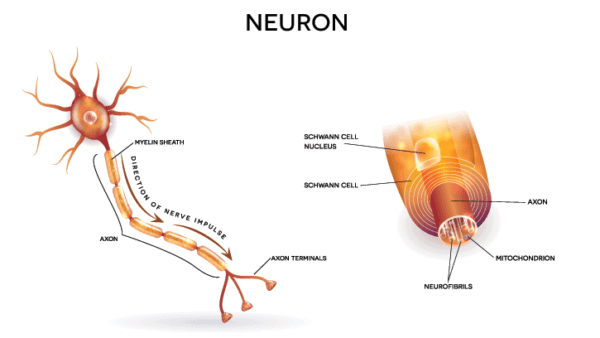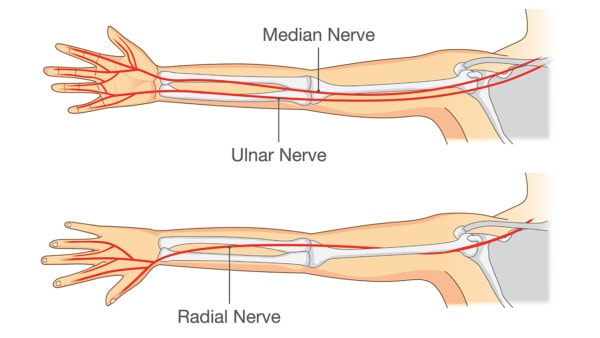Regenerating a Radial Nerve Injury with Injections?
This is a guest blog post by Dr. Jamil Bashir, who wrote up the same radial nerve injury patient that I did. I thought it would be great to get his take as the treating physician:
Regenerating a Radial Nerve Injury
In many ways our bodies are like machines. Complex organisms that enable us to successfully navigate our surroundings. When we desire to perform an action, a neuron in our central nervous system (brain), much like a circuit in a computer, sends an impulse from our motor cortex down our spinal cord. In the spinal cord, a second neuron stands ready to receive the signal of our intention and send it through our peripheral nervous system to the muscles it innervates, thus creating our actions. Our muscles rely on signals from the nerves that innervate them. Without these signals they wither and die. In fact even when we sleep our muscles remain in a constant state of low-level firing. These “tonic contractions” are low impulse signals from our nervous system that send bioelectricity through our muscle cells, giving them the constant stimulus they require for life.

Tefi/Shutterstock
In many ways our nerves are like wires. Like the plastic coated copper wires that send electricity from our walls to our computer screens, the nerve wiring of our bodies is also coated in a substance to allow faster transmission. This substance called myelin is essentially fat (one of the reasons a strict “no fat” diet is actually unhealthy), and secreted by cells that are embedded within its glossy confines. In the central nervous system these cells are called Oligodendricytes, and in the peripheral nervous system – Schwann cells. From the nerve body, these wires (or axons), project outward from the top of our head to the tips of our toes.
What happens when a nerve is damaged?
As mentioned, there are two types of nerves: central and peripheral. Central nerve damage is what occurs during a stroke, as blood flow to the brain is impaired, or during a traumatic brain injury, where shear forces act to damage neurons. Unlike the other cells in our bodies, nerves do not undergo mitosis (or division). The same neuron you had at birth is still alive today, older and wiser. This is why nerve damage is so detrimental.
Fortunately, these lifetime-loyal nerve cells do have some resilience. They can rebuild their projections (axons). This is good. Without this ability, a nerve crushed at the elbow would leave us permanently impaired. Instead, the secondary neuron in the spinal cord can send repair machinery to the injured axon and facilitate regrowth, although the regrown nerve does have some properties inferior to its uninjured former self. At times, nerves injured in the periphery are not damaged beneath the myelin coating down to the actual axons, but instead the myelin is damaged, which local Schwann cells can produce and secrete to recoat nerves and restore proper signaling.
Despite this resilience, nerves often do not fully recover from injuries. That is where Regenerative Medicine steps in. As you know, Regenerative Medicine is the quest to understand the body’s own healing mechanisms and apply them to injuries to target and amplify healing. The concept is beautifully simple–harnessing the power of blood and adult mesenchymal stem cells (amongst other healing cells), which naturally collect at sites of injury, and deciphering their mysteries to generate healing.

Solar22/Shutterstock
Now let’s take what we’ve learned and apply it to a patient recently seen in our clinic. GF is a 56-year-old active man, who enjoys playing tennis competitively. One day while firing back balls via his fine-tuned backhand, he suffered a terrible fall into the net, which left his left humerus (upper arm bone) fractured. He was rushed to the ER where Orthopedic Trauma Surgeons reconstructed his humerus using plates and screws. Unfortunately, despite their best efforts, his radial nerve was trapped under the plate used to stabilize the fracture thus severely injuring it underneath. He spent weeks in the hospital recovering, only to find upon beginning to regain his strength that his entire left arm had decreased range of motion, most notably with complete loss of finger and wrist extension.
Nerve testing revealed severe damage to the radial nerve and after a revision surgery to remove the plate, he was left with the frightful diagnosis of a severe peripheral radial nerve injury. He was told that peripheral nerves, at best, regrow at a rate of 1 mm a day, and function in his arm and hand may return in a matter of months if not years.
He presented to our clinic with the devastating loss of his left hand and wrist, as well as decreased strength in elbow flexion on exam and a severely restricted left arm with inability to lift it any higher than his shoulder. Here is where the art of what we are trying to accomplish at Regenexx really begins to unfold. After reading his reports and determining his radial nerve was damaged at a point in the humerus termed the spiral groove, we quickly assessed the left arm as a whole. Neurologic examination revealed no impairment to the musculature of the shoulder which led to a diagnosis of “frozen shoulder,” a common condition seen in any disease/injury that leads to long periods of inactivity in a joint such as a stroke or in this case a prolonged hospitalization.
Frozen shoulder is one of the conditions that responds with a very high success rate at our clinic. The treatment is actually relatively simple, from which he recovered very quickly. The decreased elbow flexion also was due to a torn long head of the biceps tendon, which also responded relatively rapidly to a Super Concentrated Platelet (SCP) injection, followed by appropriate physical therapy. Next up, the most complex injury, the peripherally injured radial nerve.
Let’s integrate what we learned from our previous discussion regarding nerves and apply our Regenerative Medicine strategies to promote healing. In this case, the nerve was crushed resulting in both injury to the myelin sheath, as well as the axon within. Under ultrasound guidance, the nerve was traversed as it spiraled around the posterior aspect of the humerus to the area of the spiral groove, and then down through the supinator muscle of the forearm where it branches into the deep and superficial radial nerve. After visualizing the nerve’s path and applying a local nerve block to make the procedure more tolerable, Platelet Lysate-Material (PL-M) was used to hydro-dissect the nerve at the site of injury at the spiral groove.
PL-M is a preparation much like our SCP, however, in this case the concentrated platelets derived from the patients own blood are lysed or opened allowing the multitude of growth factors (GF), “signaling molecules,” contained within to rapidly bathe the injured nerve. GFs contained with Platelet Lysate-Material identified as critical for nerve repair are platelet-derived growth factors (PDGF), Insulin-like Growth Factor-1 (IGF-1), Vascular endothelial factor (VEGF) and Transforming growth factor-beta (TGF-B). PDGF receptors are upregulated on axons and Schwan cells in injured nerves. PDGF stimulates neurotrophic (nerve stimulating) factors to be released, which promotes the regeneration of peripheral nerves. IGF-1 directly binds to IGF-1 receptors to stimulate the first step in myelin synthesis. The simultaneous application of both PDGF and IGF-1 can induce a more rapid regeneration than either of them alone. VEGF, induces angiogenesis (blood vessel formation) which is a critical step allowing nutrients to flood the area of repair. TGF-b can reactivate chronically injured Schwann cells, inciting them to synthesize and release neurotrophic factors, promoting myelin as well as axonal regeneration.
After three PL-M hydro-dissections of his radial nerve he has regained roughly 70% of his ability to extend his wrist and about 20% of his ability to extend his fingers. At this point we are continuing the healing process with care taken now to begin the fine needlework that must take place to restore as much finger dexterity as possible. If you recall the “tonic contractions” we discussed earlier, a finding that occurs in cases of nerve damage is formation of adhesions between individual muscles. Indeed, at times the resultant lack of function that ensues after nerve damage is a product of “bunching” together of individual muscles into clumsy, poorly coordinated conglomerates of tissue, despite re-innervation having already occurred.
In our patient’s case this is where we have arrived at in his healing journey, beginning to further hydro-dissect individual muscle fibers in his hand, in conjunction with further small nerve fiber hydro-dissections as we serve to both re-innervate the muscles, and also tease them apart from one another so that the nerves can fully reconnect in the delicate arrangement needed to give rise to fine motor movements of the hand.
The exploration of healing continues at Regenexx. Each patient’s unique case offers us the opportunity to add more pages to the annals of the rapidly evolving field of Regenerative Medicine. Best of all, we get the opportunity to see our patients heal and regain a greater quality of life, which is really what the field of medicine is, and always will be, all about.
*For references please email to [email protected]

If you have questions or comments about this blog post, please email us at [email protected]
NOTE: This blog post provides general information to help the reader better understand regenerative medicine, musculoskeletal health, and related subjects. All content provided in this blog, website, or any linked materials, including text, graphics, images, patient profiles, outcomes, and information, are not intended and should not be considered or used as a substitute for medical advice, diagnosis, or treatment. Please always consult with a professional and certified healthcare provider to discuss if a treatment is right for you.
